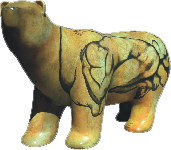


 << Back to Artists and Bears
<< Back to Artists and Bears  aumentar imagem / enlarge image Nascida em Kitwe, Zâmbia. Educada no Zimbabue, Vivendo em Portugal. Born in Kitwe, Zambia. Educated in Zimbabwe Living in Portugal. My works to date: 2008 – 2009 Current commissions “You Can’t Stand Still” – Bristol Urban Commission 2m, steel. The Pilgrims – Gateway Commission, Brentwood Essex County Council 12m, steel, mosaic & video for 2009. Rhiannon – Landmark Wales Competition – (Shortlisted), Dowlais, nr Merthyr Tydfill, Wales. 30m steel horse & rider The Deluge – Fibre Glass, fibre optics and steel, The Custard Factory Birmingham, UK. 10m hanging sculpture (underway). 2004 – 2007 Smaller Projects Converted an old farmhouse in Portugal. The Hussy – Steel, 2m, Media Complex, UK. Fountain, Concrete and cold-cast iron, 2m, Portugal. Shakespeare, Cold cast bronze, 1m. The Rose Theatre, London. 2002 – The Green Man, 12 m, concrete and steel. The Custard Factory, Birmingham. 2002 – Pair of bronze lions 1.5m. Private collection. 2000 – 2001 Converted a 7000 sq ft factory space into artist studios. 1997 – 1999 University College London. graduated in the Upper Class in Philosophy. 1995 – Wall climbing Dragon Steel, 4m. The Custard Factory, Birmingham, UK. Português Escolhi três figuras dormindo representando a humanidade nas suas diferentes formas (homem, mulher e criança) e cerquei-os de ursos dormindo. Ser capaz de adormecer indica, assim uma certa confiança. Quando temos medo, não conseguimos dormir, temos que lidar com a ameaça que temos pela frente. Ursos no seu ambiente natural são criaturas selvagens com as quais devemos ser muito cautelosos. Neste quadro o urso funciona como uma metáfora para o nosso medo. Medo da morte, medo da perda, o medo da miríade de aterrorizantes formas que o medo tem quando nos possui. Mas o urso é também um símbolo de segurança. As crianças crescem com ursos de pelúcia e apesar do temor da sua força e ferocidade na selva – ainda temos a crença contraditória de que eles são fofos. Então, o urso tem para nós esta dualidade no seu simbolismo. Esta dupla natureza da forma como pensamos no urso mostra como nós somos capazes de transformar as coisas de que temos com medo em coisas que são positivas no seu efeito sobre nós. E ainda que algumas coisas não possam nunca ser “seguras” para nós, muitos dos nossos medos ou supostas ameaças podem ser superados... English I chose three sleeping figures representing humanity in its different forms (man, woman, and child) and surrounded them with sleeping bears. To be able to fall asleep in the first instance indicates a certain trust. When afraid we can’t sleep, we have to deal with the threat facing us. Bears in the wild are creatures to be very wary of. In this picture the bear acts as a metaphor for our fear. Fear of death, fear of loss, fear of the myriad, terrifying shapes that fear takes when it possesses us. But the bear is also a symbol of safety/security. Children grow up with teddy bears and in spite of being in awe of their strength and fierceness in the wild – we still have the (daft) contradictory belief that they’re cuddly. So the bear has a duality in its symbolism for us. This dual nature of how we think of the bear shows how we are able to transform those things we are afraid of into things that are positive in their effect on us. And while some things might never be “safe” for us, many of our fears or supposed threats can be overcome... |